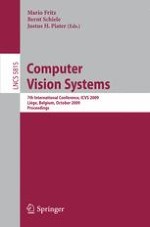This book constitutes the refereed proceedings of the 7th International Conference on Computer Vision Systems, ICVS 2009, held in Liege, Belgium, October 13-15, 2009. The 21 papers for oral presentation presented together with 24 poster presentations and 2 invited papers were carefully reviewed and selected from 96 submissions. The papers are organized in topical sections on human-machine-interaction, sensors, features and representations, stereo, 3D and optical flow, calibration and registration, mobile and autonomous systems, evaluation, studies and applications, learning, recognition and adaption.
